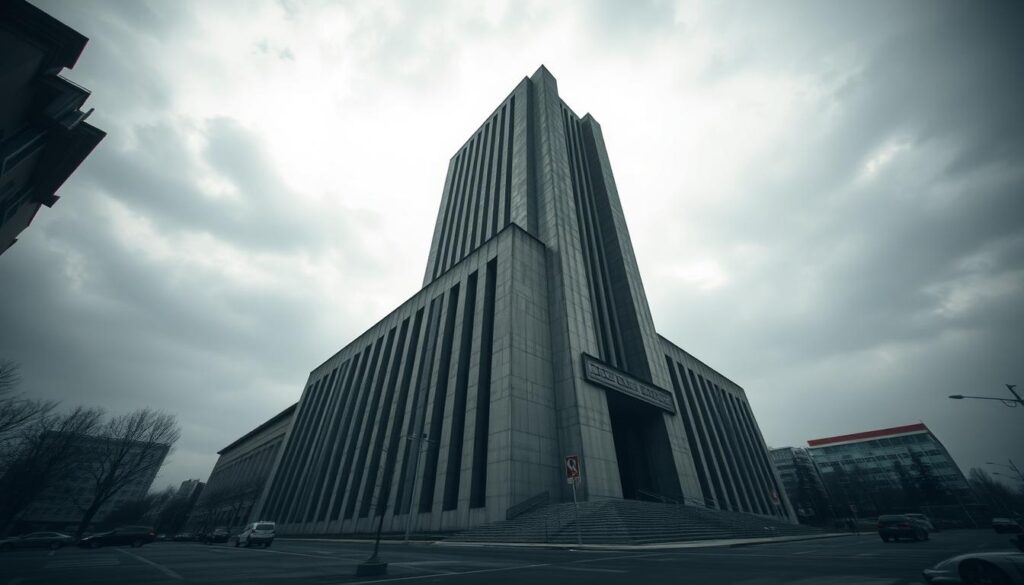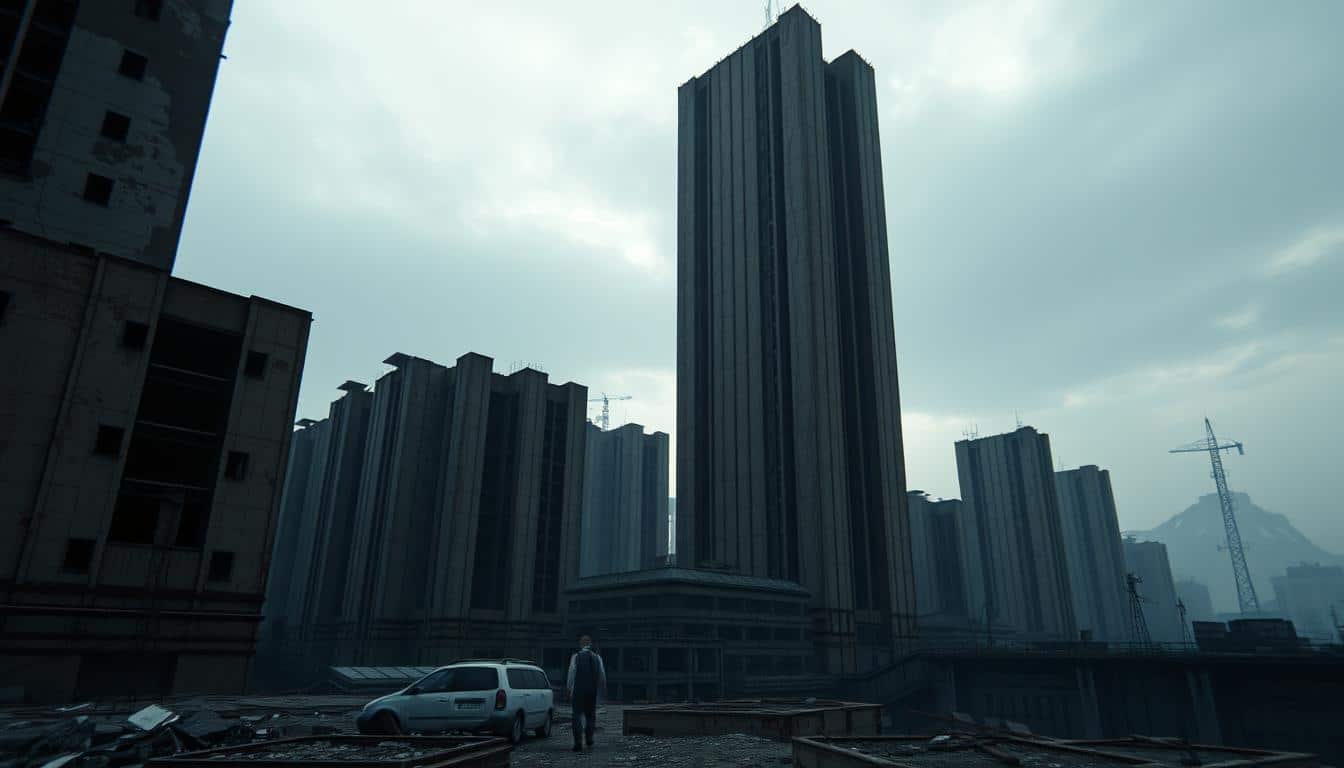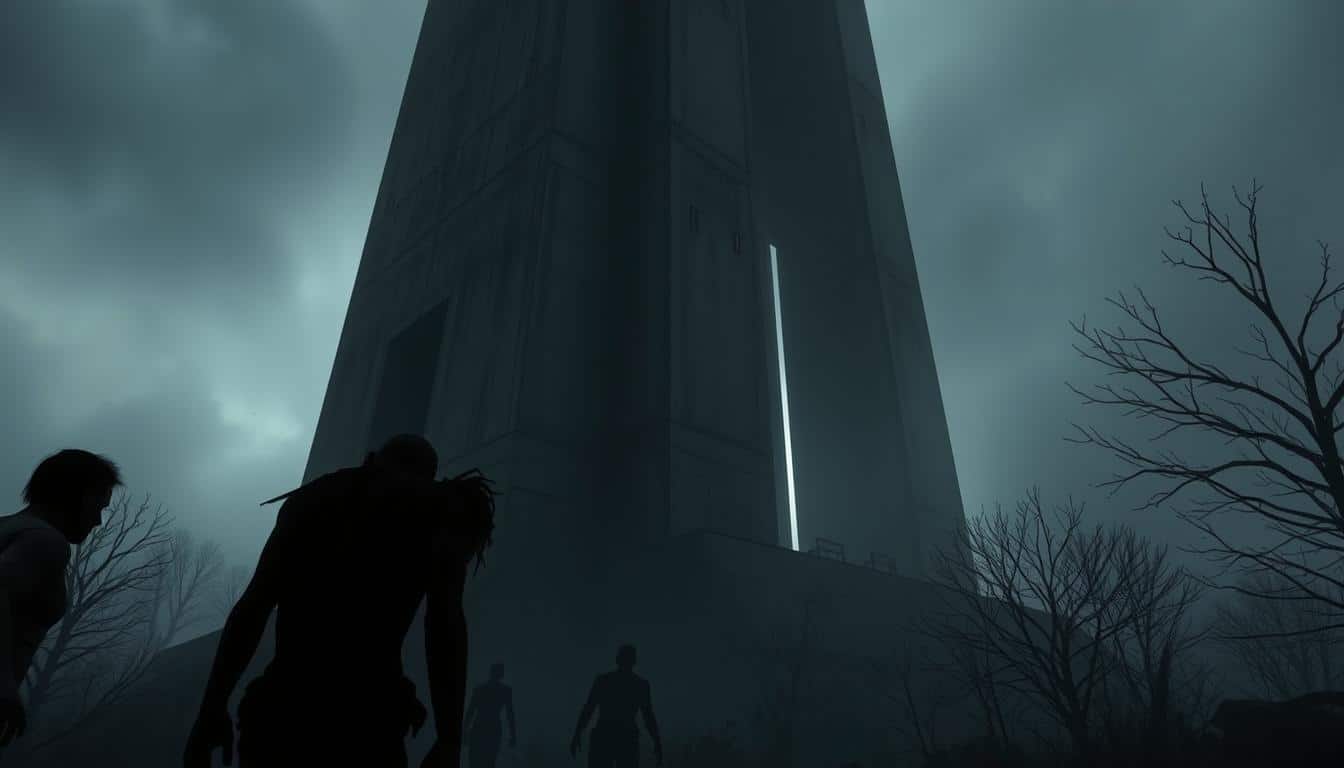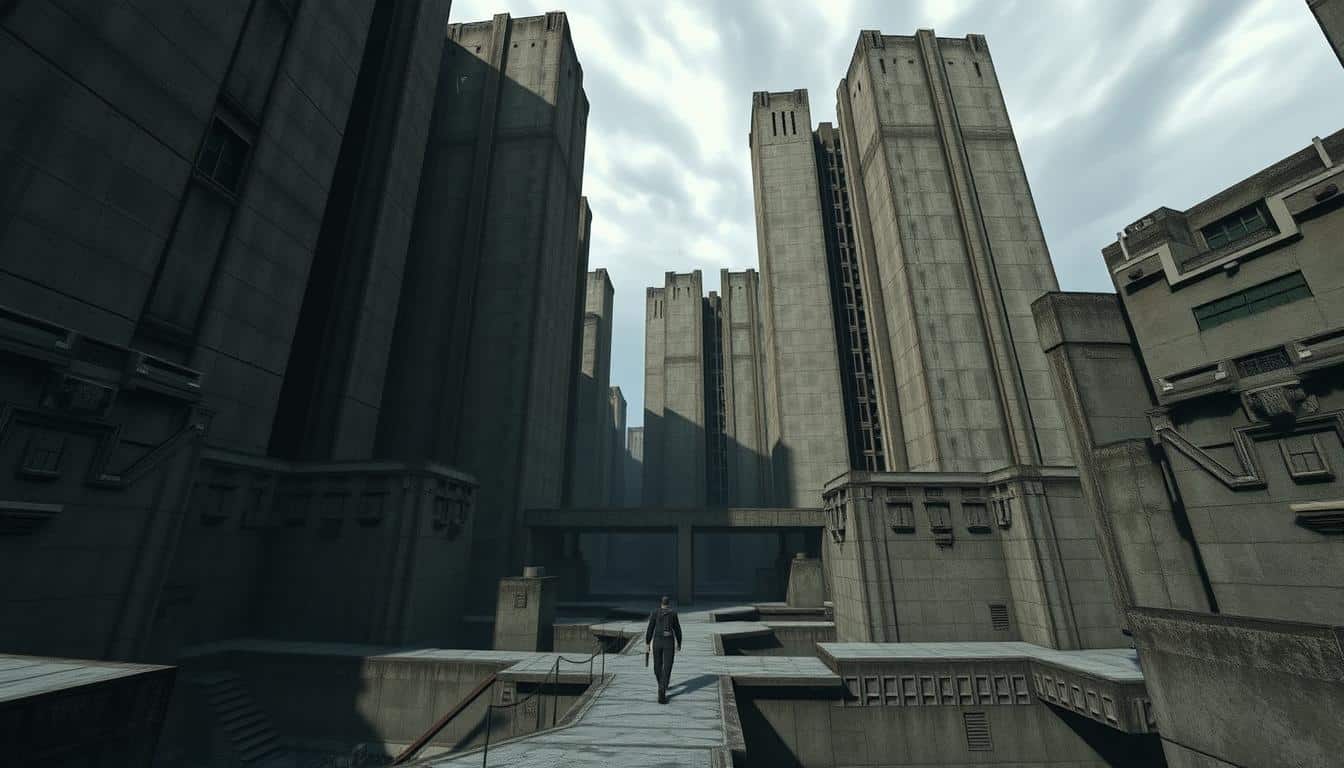Soviet brutalism is known for its bold, raw looks and huge designs. It holds a special spot in the world of video games. Game creators use these strong architectural styles to make absorbing worlds that players love. This piece looks at how the unique charm of Soviet brutalism affects video game design and storytelling. It shows how this building style influences how players feel and connect with games. We’ll see the blend of architecture and digital fun through this lens.
Introduction to Soviet Brutalism
Soviet brutalism started after World War II, responding to the era’s social and political issues. It used raw concrete and focused on usefulness in its designs. The style features big, bold shapes that show the era’s cultural and ideological battles.
Soviet Union architecture is more than buildings. It shows the political and cultural beliefs of the society. Brutalism’s practical and unique look connects deeply with people. It shapes cities and influences art and video games today.

Defining Brutalism: Characteristics and Origins
Brutalism comes from the French word béton brut, meaning raw concrete. It’s an architectural style that started in the late 1940s. It focuses on simple, functional design and showing off materials as they are. Architects like Le Corbusier were key in starting this movement. They created iconic buildings, such as the Unité d’Habitation, that show what brutalism is all about.
Brutalism is known for its textured concrete and modular designs. These elements come together under a minimalist approach. This simplicity creates open, adaptable spaces inside and straightforward exteriors. It highlights the beauty of the materials used. These features have influenced not just buildings, but also art and video games. In games, players explore worlds that show off brutalism’s unique qualities.
Soviet Brutalism: A Reflection of Cultural Ideals
Soviet brutalism marks an era shaped by cultural and Soviet values. More than just a style, it symbolizes the collective challenges and dreams of its time. These huge buildings were made to impress and express a vision of progress, mirroring the ambitions of the leaders.
Architecture from this time shows the state’s ideologies, highlighting design as a mirror of a nation’s spirit. These buildings, with their stark designs and raw materials, tell stories of a society founded on strict values. They bring to life tales of hardship and perseverance, making them important for discovery and storytelling.
In video games, these brutalist themes become very powerful, adding depth to stories about control and society. Using brutalist architecture in games not only makes them look better but also comments on past struggles. As gamers move through these environments, they see history’s shadows, prompting them to think about the complex mix of culture and Soviet ideals.
The Role of Brutalism in Post-War Architecture
After World War II, architecture took a big turn. The world needed to rebuild the destruction. During this time, brutalism became a key style. It used cheap materials and simple designs to help cities quickly recover from their losses.
Brutalist buildings stood for strength and resilience. They were designed with bold, geometric shapes. These shapes brought a sense of stability to communities. People found hope in these strong designs amid post-war challenges.
When cities were being rebuilt, brutalism was important. It focused on being useful more than looking good, matching the practical needs of the time. This style didn’t just change cities, but also affected video games. These games reflect similar themes of strength and stability.
Exploring Soviet Brutalism in Video Games
The design of video games has been deeply influenced by Soviet brutalism. This style uses a lot of concrete and sharp shapes. Game developers use these elements to make their worlds feel real and impactful.
They aim to pull players into the game by making them feel certain emotions. These can range from feeling trapped to feeling lost. This makes the game’s story more engaging and intense.
Influences of Soviet Architecture on Video Game Design
Games today show a lot of Soviet architecture’s bold and practical style. This style pushes game designers to create places that feel true to the brutalist look. Players find themselves in settings that are not just interesting, but also meaningful, reflecting the Soviet time.
This not only makes the game feel real but also adds depth to the gameplay. It gives a unique atmosphere that enhances the whole gaming experience.
Examples of Games Incorporating Soviet Brutalism
Many games have brilliantly included Soviet brutalism in their worlds. For example, “Control” has huge buildings that really show off brutalist design. This adds a mysterious and unsettling vibe to the game.
“S.T.A.L.K.E.R.” is another game that captures the feel of abandonment with its rundown settings. These games use architectural styles to leave a lasting impression on players.
Notable Video Games Featuring Soviet Brutalism
Several games have woven elements of Soviet brutalism into their fabric. They use the stark, powerful look of brutalist architecture to tell captivating stories and create immersive gameplay.
Control: The Monolithic Oldest House
In “Control,” the game’s setting, the Oldest House, is like a brutalist skyscraper. It’s full of eerie hallways and vast spaces. These elements make you feel lost and add to the game’s mysterious mood.
The brutalist style ups the atmosphere’s creep factor. It’s perfect for the game’s mix of the strange and unknown.
S.T.A.L.K.E.R.: Abandonment and Decay
“S.T.A.L.K.E.R.” sends you through a post-apocalyptic world full of ruins. It captures the eerie feel of a world left behind. The game uses these scenes to bring out feelings of emptiness and despair.
Its brutalist settings highlight the story’s focus on survival. They show the heavy toll of living in a world forgotten by time.
Papers, Please: A Study in Oppression
“Papers, Please” uses brutalism to create a suffocating, dystopian setting. Its visuals and gameplay immerse you in a world where everything and everyone is watched. The game’s design echoes the bleakness around you.
This helps push its themes of control and power, making moral choices more impactful. It drives home the experience of being trapped in a harsh regime.
Artistic and Philosophical Implications of Brutalism in Games
Brutalism in video games adds depth to the player’s experience. The simple, rough look of brutalist architecture brings up big ideas. It makes players think more about their surroundings. This style often shows existentialist ideas, asking big questions about life and how societies work. In these games, players face the hard truths shown in the stories.
The game worlds make players feel strong emotions. They make players think about existence and what’s right or wrong. As players move through these spaces, they see stories that change how they think. They feel things about their own lives. This deep thinking turns playing into a journey of thought. It pushes players to think about bigger criticisms shown in the game’s art.
Game creators put a lot of effort into including these art elements. They turn a simple game into a deep reflection on life and society. By using philosophical ideas in games with brutalism, they start conversations. They make gaming a place for deep thought.
Player Experience: The Mechanics of Navigating Brutalist Worlds
Brutalist worlds in games offer unique challenges. Their large, simple structures and plain look pull players deep into the game. Here, players face hurdles and chances that push them to adapt and think ahead.
Engagement through Aesthetic Challenges
How you move through brutalist areas in games shapes your experience. These areas can be maze-like, urging players to explore and connect deeply with the game. They have to think over their plans to beat the game’s challenges. Such design choices combine story depth with visual style, making the game more immersive.
Brutalist Aesthetics in Modern Game Design
Nowadays, games increasingly show off brutalist designs, mirroring modern trends. This method uses bold and simple elements of brutalism to create captivat
ing game environments. Indie game creators, in particular, like to use these ideas to break the usual rules and bring something new to players.
As games continue to evolve, brutalist styles are becoming more common. You’ll see lots of straight lines, bare surfaces, and big, imposing structures. This makes game worlds more intense, pushing players to feel more as they explore.
Games like “Control” and “Returnal” really stand out by using brutalist styles in their worlds. This design choice helps make the game’s atmosphere feel lonely or eerie. Every game does this in its own way, offering something for all types of gamers.
In the end, as game makers keep mixing brutalist looks into their games, they are creating new kinds of playing experiences. They’re getting inspired by old architectural styles, leading to innovative stories and game actions. This proves just how important these designs are in video games today.
Conclusion
Exploring Soviet brutalism in video games shows a deep link between architecture and gameplay. This style affects both the game’s look and its story, making the game more engaging. By looking at brutalism’s unique features, we understand how its bold shapes challenge players. This encourages them to dive deeper into the game worlds.
The influence of brutalism in games is still strong as the industry grows. Future games will likely use this style to spark emotional reactions and tell deeper stories. The conversation between architecture and gaming isn’t just making games better. It’s also pushing the whole genre to innovate.
To wrap it up, brutalism’s fascination will keep influencing video game worlds. As game makers find new ways to include these designs, players will find more creative and engaging games. These games will continue to connect architecture with the art of gaming.



